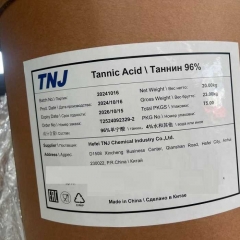Gallic acid anhydrous powder (CAS 149-91-7) is obtained from nutgalls and other plants or by the hydrolysis of tannic acid with sulfuric acid. Gallic acid exists in white crystalline powder,soluble in water (11.5 mg/ml), ethanol, acetone, and Alcohol. Insoluble in chloroform. Gallic acid is commonly used in the pharmaceutical industry. It is used as a standard for determining the phenol content of various analytes by the Folin-Ciocalteau assay; results are reported in gallic acid equivalents. Gallic acid can also be used as a starting material in the synthesis of the psychedelic alkaloid mescaline.
Specification
| Item | Pharma grade | Food grade | Industrial grade |
| Content, % | ≥99.7 | ≥99.5 | ≥99.0 |
| Loss On Drying, % | ≤5.0 | ≤5.0 | ≤10.0 |
| Residue on Ignition, % | ≤0.10 | ≤0.10 | ≤0.10 |
| Tannic acid, % | ≤1.0 | ||
| Sulphate, ppm | ≤10.0 | ||
| As, ppm | ≤3.0 | ||
| Pb, ppm | ≤10.0 |
Application
- Widely used in medicine, dyestuff, chemicals and organic synthesis, and also used for the analysis of rare metal.
- Has antibacterial effect, but in the treatment of bacillary dysentery.
- Have convergence, hemostatic, anti-diarrhea effect.
- Used as a preservative. To the preparation of pyrobitumen medium of gallic acid, medicine, ink, dye and explosion-proof agent, etc.
- Also used as a developer and detect free inorganic acid, dihydroxyacetone, alkaloid and metal such as analytical reagent.
.
Packing
25kg in fiber drum, 9tons in 20ft container





 TDS Gallic acid.pdf
TDS Gallic acid.pdf
 chemical.tnj
chemical.tnj +8618949823763
+8618949823763 tnjchem
tnjchem 2881500864
2881500864